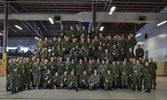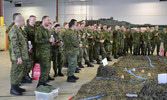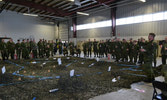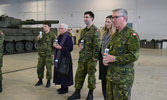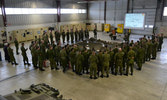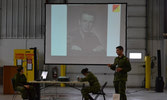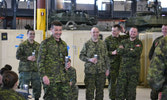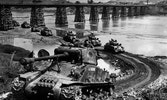A Year In The Life of B Squadron, Staying Connected To Our Past
By: Cpl Alison Sawyer
On 6 February 2015, B Squadron gathered for promotions and a presentation on the Korean War. Tpr Matthew Bond, Tpr Carter Dillon, Tpr Justin Champagne, and Tpr Michael McNeil were the members that were promoted followed by a squadron picture while all holding tasty beverages purchased by LCol Jason Adair; who stated that if he was keeping us on a Friday afternoon without beer that his grandfather would shoot him.
The squadron gathered around a Korean War map model in the middle of the hanger floor. Our guests for the afternoon consisted of former B Squadron Officers Commanding: LCol Mark Connolly, Maj Mike Onieu, and Maj Clayton Gardner, along with a special guest, Mrs Penny Gross, mother of Paul Gross who directed, co-produced, and acted in the movie Passchendaele. The presentation was conducted by LCol Adair (Commanding Officer of 3 PPCLI). The focus was B Squadron during the Korean War “through the tank goggles” of LCol Adair’s grandfather, Lt Bruce Rutherford, a Troop Leader in B Squadron during the war.
The story began with a different Lt Rutherford, Lt Tom Rutherford, LCol Adair’s great grandfather and father to Bruce Rutherford, whose career began with the 4th Canadian Mounted Rifles as a platoon commander where he fought in the battle of Passchendaele. In June of 1940, he was promoted to lieutenant-colonel and then became the Commanding Officer of the Grey and Simcoe Foresters. They were an infantry regiment who saw the light and later mobilized and became an armoured regiment during the Second World War.
In England 1945, another war hero by the name of Tpr Bruce Coleman Rutherford just arrived as a tank gunner with the Royal Canadian Dragoons. He was later promoted to Lance Corporal by the end of the war in Germany. When the war ended, he decided to go to university where he took a two-year degree at the University of Toronto in the Canadian Officer Training Corp (COTC) and eventually decided to stick with his beloved Royal Canadian Armour Corps (RCAC). In 1948-1949 he completed his phase training in Camp Borden, the home of the RCAC at the time, and then became an officer with Lord Strathcona’s Horse (Royal Canadians).
In the fall of 1949, 2Lt Bruce Rutherford, his wife, and young son arrived at Currie Barracks (in Calgary) where the Strathcona’s were posted at that time, alongside the Princess Patricia’s Canadian Light Infantry. On his arrival at Currie Barracks, he was met by LCol A.G Chubb who was the Commanding Officer of the Strathcona’s from June 1947 to May 1951.
Canada in 1950 was the year of the first Trans-Canadian flight, the Winnipeg floods (some things never change) and the Detroit Redwings “somehow” won the Stanley Cup. On 25 June 1950, North Korea, backed by the Soviet Union, came across the 38th parallel and attacked South Korea, who was caught off guard. The Americans were also caught off guard and there was a massive withdrawal of United Nations forces.
Canada’s naval units were the first to respond along with the UN and soon after the RCAF sent transport aircraft and fighter jets to Kimpo Airfield in South Korea. The 25th Canadian Infantry Brigade (Canada’s Army Special Service Force), formed by a majority of volunteers, was led by Brigadier John M. Rockingham and deployed in 1951.
The war began as a mobile war and eventually became a static “war of patrols”. The allied forces were in a series of defences all along the 38th parallel between the North and the South. For B Squadron, “Baker Squadron” as it was known at the time, this meant manning static defensive positions on hills supporting infantry patrols. The tank crews were completely dug in using spare tank track for added protection around their vehicle. They remained relatively static from 1951-1953. To remain protected while in and out of the tanks, crews exited through the co-drivers escape hatch, allowing them to remain unexposed. The Sherman tank was used during the Korean War, packing a 76mm gun, two x 30mm machine guns, and a 50.Cal on the top of the turret.
On 13 May 1952, B Squadron soldiers were on their way to replace C Squadron who were the first Strathconas in Korea. B Squadron sailed for fourteen days initially arriving in Japan before making their way to the front lines to replace C Squadron. When the soldiers finally arrived in Korea on 2 June 1952, they immediately began taking fire. The tanks dug in on the high features continuously received artillery and mortar fire from the enemy as they were big static targets and “sitting ducks.” Shortly afterwards, B Squadron moved back from the front lines which is where the famous picture of “Catherine” in front of a column of Sherman tanks crossing the Imjin River was taken. B Squadron was moving the tanks back to get painted with B Squadron markings, so this picture of Catherine was being crewed by B Squadron soldiers, with Lt Rutherford commanding the second tank in the column.
B Squadron fought several large Chinese attacks over the year including 22-24 Oct 1952 when B Squadron participated in The Battle for Kowang-San (Hill 355 also known as Little Gibraltar). This was one of the bloodiest battles of the Korean War which included 18 x Canadian KIA, 35 x Canadian WIA, and 14 x Canadian POW. From 2-3 May 1953, B Squadron was involved in the Battle for Hill 187, which pointed across the Sami-Ch’on Valley, the last battle Canadians fought in Korea. Approximately 2000 Chinese soldiers attacked 3 RCR’s position, which included 3rd Troop, B Squadron. They eventually repelled the attack, but Canada suffered the most casualties during this battle than any other battle during the Korean War – 25 x KIA, 27 x WIA, 7 x POW. A Squadron eventually replaced B Squadron in Korea, but not before B Squadron lost three soldiers:
14 Jun 1952 – Tpr Kenneth Allen Gray, a C Squadron replacement who stayed after the B Squadron handover, felt ill for several days before collapsing in his bunker and eventually dying of hemorrhagic fever.
20 Aug 1952 –Tpr Leonard Neufield. Just after 9 o’clock, Sgt Daniel’s tank was hit by a Chinese shell injuring all 5 crew members, killing the driver Tpr Neufield and destroying the first of two tanks that B Squadron lost during the Korean War.
2 Oct 1952 – Tpr Gordon Waldner was killed during the Chinese bombardment of Hill 355 in preparation for their attack later in the month. A shell buckled the side of the turret and killed Tpr Waldner.
During their time in Korea, B Squadron suffered three killed, however many were wounded and two tanks were destroyed. A total of 516 Canadians were killed during the war. A few Strathconas are buried in Pusan, Korea to this day. Retired Major Bruce C. Rutherford passed away in December 2013. He was known for his love of being a soldier, cared deeply for those with whom he served, and developed a reputation as an outstanding leader, tactician, and instructor of many excellent leaders to come. B Squadron would like to thank LCol Jason Adair for sharing with us his family history and their involvement in the Korean War.

